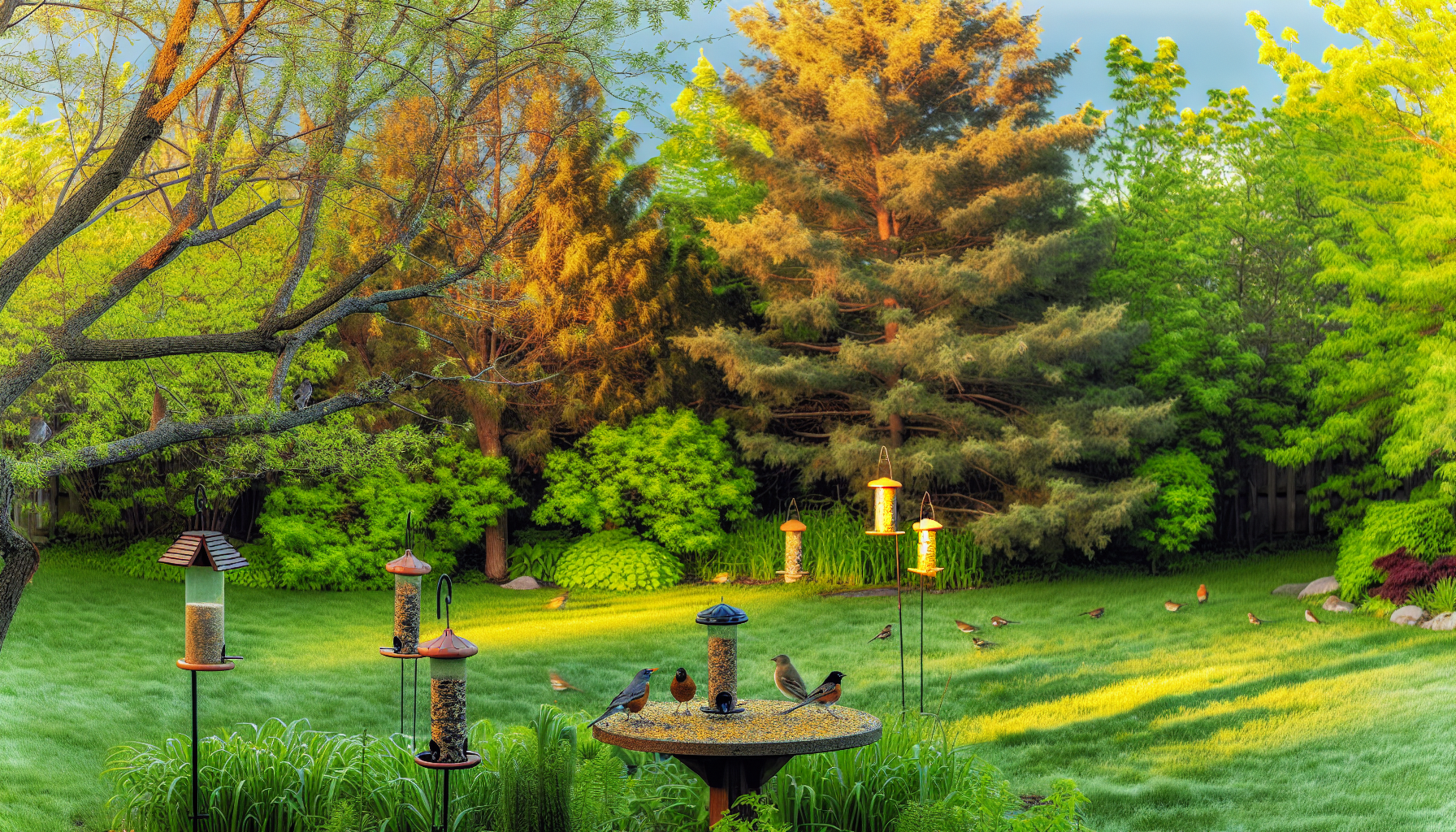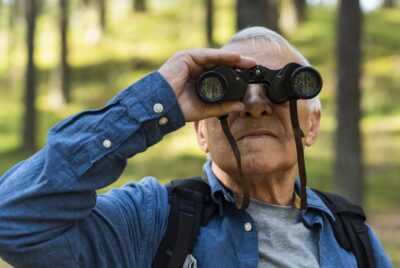What is the Best Time to Bird Watch in the Backyard?
Eager to spot a parade of feathers in your backyard? What is the best time to bird watch in the backyard? The best time for birdwatching hinges on two key periods: early mornings and late afternoons. During these times, your backyard becomes a bustling hub of bird activity, ideal for viewing and identifying various species. Without spoiling the why and how—those details await in the following sections—grab your binoculars when light first graces the sky, or as shadows grow long before dusk, and prepare for a spectacular show right in your own garden.
Key Takeaways
Early mornings and late afternoons are prime birdwatching times in your backyard, with birds being most active during these periods.
Seasonal patterns greatly affect bird activity, with spring and fall migrations offering unique opportunities to see different species.
Having the right equipment like quality binoculars, bird guides, and a camera, along with creating a bird-friendly environment, enhances the birdwatching experience.
Prime Time for Backyard Birdwatching

Have you ever pondered over the optimal time to observe the bird spectacle in your backyard? In birdwatching, timing plays a pivotal role. Birds, just like humans, follow daily routines. Most birds are diurnal, meaning they’re active during the day and rest at night. Therefore, understanding when they’re most active can significantly enhance your birdwatching experience.
Early mornings and late afternoons serve as the peak hours for backyard birdwatching, offering ample opportunity to observe and identify diverse bird species. The early morning is prime time for birdwatching. As the sun rises, birds become vocal and active, making them easier to spot. It’s an exciting time when the world slowly comes to life, and the early bird indeed catches the worm.
However, it’s not just the early mornings that offer a delightful show. As the afternoon wanes, another peak of activity occurs. Late afternoons usher in a different ensemble of bird behaviors and species, ensuring a birdwatching experience like no other.
Early Morning
The time around dawn is a magical period known as the ‘dawn chorus,’ a term used to describe the cacophony of birdsong that erupts as the sun begins to rise. After a night’s rest, birds tend to be hungry and consequently more visible and active as they forage for food.
While the rest of the world is still rubbing the sleep from their eyes, birders are already in their element, binoculars in hand, ready to witness this dawn spectacle. Hence, for the early birds among us, the hours before breakfast could soon transform into the highlight of the day.
Late Afternoon
As the day wears on and the heat of the noon sun begins to wane, the mid afternoon presents a transition period, leading to the late afternoon which is another prime time for birdwatching. The soft light of the fading sun provides optimal lighting conditions, with the sun at the birdwatcher’s back, enhancing the visibility of bird species.
Different bird species display peak activity patterns in the late afternoon that differ from those in the morning, providing a unique birdwatching experience. So, if you’re not an early riser, don’t worry. The late afternoon offers another perfect window to catch these feathered creatures in their element.
Seasonal Birdwatching Patterns

The timing of the day holds significance, and so do the seasons. Bird watching opportunities can significantly vary with seasons, offering unique experiences throughout the year. Each season presents its unique showcase of bird life, from the arrival of migratory birds in spring to the flocking patterns in autumn. So, it’s always a great time to bird watch.
While many bird species are most active in the early morning, some birds, like Ducks, are active throughout the day, making them ideal for birdwatchers who prefer not to follow the early-morning patterns. And for those interested in observing nocturnal avian species, like owls, the best birdwatching experiences occur late at night, especially on calm, moonlit evenings.
Whether you’re a morning person or a night owl, opportunities to observe these feathered marvels abound. Now, let’s explore how each season unravels a distinct spectacle for birdwatchers.
Spring
Spring is a season of rejuvenation and new beginnings. It’s also a time of unique migratory patterns like ‘loop migration,’ where birds, such as the Connecticut Warbler, take different routes compared to fall. This period, known as the spring migration, witnesses the arrival of a variety of migratory birds, making it an exciting time for birdwatchers.
Aside from migration, spring is also the nesting season, demanding high energy investment from birds. Species like Indigo and Lazuli Buntings begin their nesting period, utilizing materials like spider web to strengthen their nests and raising broods into the summer. As birds begin their days early in the spring season, birdwatchers are advised to start observations at sunrise or even earlier to capture the full spectrum of avian activity.
Summer
As we move into summer, the days grow longer, and many birds engage in various territorial behaviors to protect their offspring and territory. Birds like mockingbirds and plovers employ tactics such as dive-bombing and feigning injury to deter potential threats from their nests.
Bird species that nest on beaches, such as black skimmers and least terns, may form large colonies and collectively dive-bomb predators to protect their exposed nests. These fascinating behaviors make summer birdwatching a thrilling experience, especially when observing common species among the many species found in these areas.
Fall
Fall is a time of transition. It prompts many bird species to migrate, making it an interesting time for birdwatchers to observe large-scale movements. Species commonly seen in large flocks soaring south during the fall migration include:
Geese
Cranes
Starlings
Swallows
Robins
Apart from the migratory travels, flocking behavior serves as a strategy for increased safety from predators and more efficient foraging among local bird populations. Additionally, fall is also a time when birds molt to prepare for winter, shedding more feathers and growing a new protective coat.
Winter
As winter sets in, the landscape transforms. The absence of leaves creates a monochromatic landscape, improving visibility for birdwatchers. Birds have limited daylight hours to find food in winter, making sunrise particularly critical for their activity and observation.
Providing a water source becomes crucial during this season. Implementing a heater or de-icer in bird baths can prevent freezing, ensuring that birds have access to water even in colder winter climates. So, while the rest of the world hibernates, birdwatchers can continue to enjoy their favorite pastime.
Essential Birdwatching Equipment

Similar to other hobbies, birdwatching necessitates some basic equipment. Possessing the appropriate gear can markedly improve your birdwatching experience. From binoculars to bird guides and cameras, each tool plays a crucial role in spotting and identifying birds.
Binoculars serve as the constant companion of a birdwatcher. They offer a detailed view of birds, assisting in their identification and in scanning an area to locate them. Optimal binoculars for birdwatching are lightweight and compact, providing a balance between portability and image quality.
But the tools don’t end at binoculars. Bird guides and cameras are also indispensable to enrich the birdwatching experience. Bird guides are an essential tool for correctly identifying local bird species and learning about their characteristics and behaviors. While a camera with a good zoom and quiet shutter can greatly enhance birdwatching by allowing for detailed photography of birds without disturbing them.
Binoculars
Quality binoculars are a birdwatcher’s greatest asset. Lightweight binoculars are crucial for comfort and prolonged birdwatching sessions. High-quality binoculars that are also lightweight make it easier to stay mobile and alert during birdwatching.
Not only should your binoculars be:
Lightweight
Waterproof
With superior magnification
High-quality lenses
Investing in binoculars that meet these criteria is essential for the best birdwatching experience.
Bird Guide
While binoculars help you spot birds, bird guides help you identify them. Bird guides are an essential tool for correctly identifying local bird species and learning about their characteristics and behaviors.
There’s a wealth of bird guides available, from traditional books to modern apps. For instance, the Merlin Bird ID app is a user-friendly tool for beginners with a simple step-by-step identification process and a database featuring 400 common bird species. For more experienced birders, platforms like eBird provide up-to-date sightings in the area and function as a global birding tool.
Camera
A camera is another valuable tool in a birdwatcher’s arsenal. A camera with a good zoom and quiet shutter can greatly enhance birdwatching by allowing for detailed photography of birds without disturbing them.
There are numerous camera options available in the market catering to different needs and budgets. Whether you’re a beginner or a professional bird photographer, the key is to choose a camera that suits your specific needs. From the Nikon Z9, a professional bird photography choice, to the Canon EOS R10, which appeals to newcomers, there’s a camera out there for every birdwatcher.
Attracting Birds to Your Backyard

Now that you are armed with the necessary tools and knowledge, the next step is to develop a bird-friendly habitat in your backyard. Drawing a variety of birds necessitates a bit of effort and strategic planning. Here are several ways to create a welcoming space for birds:
Incorporate different types of bird feeders
Ensure a fresh water supply with features like fountains
Plant native plants and trees that provide food and shelter for birds
Create nesting areas with birdhouses or nesting boxes
Minimize pesticide use to protect birds and their food sources
By implementing these strategies, you can create a thriving bird habitat in your backyard.
Additionally, bird-friendly landscaping with native flora offers colorful flowers and berries while providing shelter for safety and warmth through birdhouses or natural foliage. Encouraging birds to build nests in your yard can be facilitated by offering nesting materials in accessible locations, such as grass clippings or pet hair in a suet cage.
Remember, the goal is not just to attract birds but to create an environment that caters to their needs and encourages them to return. Why not transform your backyard into a haven for birds?
Bird Feeders
Bird feeders play a crucial role in attracting birds to your backyard. Different species of birds have distinct preferences for feeder types and feeding heights; providing a variety of feeders can help attract a diverse bird population.
Some types of bird feeders include:
Tray or platform feeders that serve a wide range of birds
Suet feeders that cater specifically to species like woodpeckers and nuthatches
Nyjer feeders that attract finches
The right feeders can transform your backyard into a birding hotspot. Remember, the key to successful bird feeding is not just about providing food but also ensuring that the feeders are clean and safe for birds.
Bird Baths
Just as humans need water to survive, so do birds. Providing a water source in the backyard is crucial for bird hydration and health, as birds need water for bathing and drinking.
A bird bath can be as simple or as elaborate as you want it to be. Incorporating elements like pumps or misting devices that produce moving water can attract a greater variety of birds. Regular cleaning of bird baths is necessary to prevent algae growth, insect breeding, and chemical contamination, which can be detrimental to bird health.
Native Plants
In addition to bird feeders and bird baths, planting native species supports the local ecosystem and attracts local birds. A mix of shrubs, trees of varying heights, and ground covers cater to the preferences of different bird species.
Creating layers of vegetation that include ground covers, understory, and canopy layers mimics natural habitats and provides birds with diverse feeding and nesting opportunities. So, by planting native species, not only are you adding beauty to your backyard, but you’re also providing a natural habitat for birds.
Connecting with Fellow Birdwatchers

Birdwatching transcends mere observation of birds; it also fosters community. Building connections with fellow birdwatchers can elevate the birding experience as it enables individuals to learn from each other and share their mutual passion for birds.
Whether it’s through birdwatching clubs or online communities, connecting with fellow birdwatchers can offer camaraderie and advice from fellow enthusiasts, creating a shared experience that can enrich your own birdwatching journey. After all, birdwatching is not just a hobby; it’s a community of individuals who share a common passion for the beauty and wonder of birds.
Birdwatching Clubs
Birdwatching clubs offer programs and outings, including birding trips, for birders of all skill levels, which can be especially beneficial for those new to the hobby. Veteran birders often serve as mentors, providing guidance on bird identification, usage of equipment, and birdwatching ethics.
Joining a birdwatching club can open up a world of opportunities. From sharing tips about the best times for birdwatching to having access to private lands or restricted areas where birdwatching opportunities are particularly good, birdwatching clubs can greatly enhance your birdwatching experience.
Online Communities
In the digital age, online communities have become a popular platform for birdwatchers to connect, learn, and share their experiences. Participating in online birdwatching communities offers camaraderie and advice from fellow enthusiasts.
Platforms like eBird and social media pages of local birdwatching clubs are popular online spots where enthusiasts gather. Specialized forums such as BirdForum provide various discussion topics including Bird Identification Q&A and Rare Bird News, facilitating learning and community engagement around birdwatching.
Summary
In conclusion, birdwatching is a rewarding hobby that offers myriad benefits. From the joy of spotting a new species to the tranquillity of observing nature’s orchestra in your own backyard, birdwatching is an experience like no other. With the right tools, timing, and community, anyone can discover the joy of birdwatching. So, grab your binoculars, step into your backyard, and let the birds serenade you!
Frequently Asked Questions
What time of day is best for bird watching?
The best time for bird watching is in the morning, between dawn and 11am when the birds are most active and singing. Enjoy your bird watching!
What are the best conditions for bird watching?
The best conditions for bird watching include warm and sunny days, but overcast or slightly rainy days can also be good as birds stay active and singing later in the day. Remember, optimal weather can vary depending on the season and migration patterns.
What is the best time to do a bird count?
The best time to do a bird count is usually between 5 and 9 a.m. at most temperate latitudes during the breeding season, ideally starting within 15 minutes of local sunrise. Avoid counting after 10 a.m., unless it’s in the non-breeding period.
How do birdwatching opportunities vary by season?
Birdwatching opportunities vary by season, with the arrival of migratory birds in spring and flocking behaviors in autumn offering unique experiences. Enjoy spotting different bird behaviors throughout the year.
What is the essential equipment for birdwatching?
The essential equipment for birdwatching includes binoculars, bird guides, and a camera for photography. These tools will help you spot, identify, and capture the beauty of different bird species.




